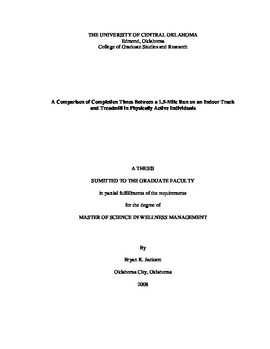| dc.contributor.advisor | Fent, Darla | |
| dc.contributor.author | Jackson, Bryan K. | |
| dc.date.accessioned | 2020-02-14T17:50:04Z | |
| dc.date.available | 2020-02-14T17:50:04Z | |
| dc.date.issued | 2008 | |
| dc.identifier | (AlmaMMSId)9973553685202196 | |
| dc.identifier.other | (AlmaMMSId)9973553685202196 | |
| dc.identifier.uri | https://hdl.handle.net/11244/323726 | |
| dc.description.abstract | The purpose of this study was to compare the 1.5-mile run test performed on an indoor track to the 1.5-mile run test performed on a treadmill in a group of physically active adults 19 to 30 years of age. The study compared completion times on both tests, which were conducted within a two-week period at least seven days apart. A total of 30 subjects (n = 30) consisting of males (n = 15) and females (n = 15) participated in this study. On both the indoor track and treadmill runs, subjects completed 1.5 miles as fast as possible and completion times were recorded. Times were called out to subjects every quarter mile during each run. On the indoor track run, 18 laps on the inside lane was equivalent to 1.5 miles. On the treadmill run, subjects were responsible for adjusting their own speed using the treadmill's speed control. Findings and Conclusions: Data was analyzed using SAS (version 9.1). Differences between independent means were compared by two-tailed t-tests. Differences between dependent means were compared by two-tailed paired t-tests. Differences between proportions were compared by two-tailed Fisher's exact tests. Correlation between two variables was determined using Pearson's coefficient (one continuous variable and one categorical variable) or the phi coefficient or Fisher's exact test (two categorical variables). Multiple regression was used to determine the best-fitting model to predict treadmill times. P-values less than .05 indicated significant differences as well as collinearity. This study found no significant difference in completion times on a 1.5-mile run performed on a track versus a treadmill for both genders (p = .122), males only (p = .329), and females only (p = .223). These findings demonstrate that using a treadmill to conduct a 1.5-mile run test is an appropriate method that can be used to estimate cardiorespiratory endurance in young, physically active adults. Additionally, lifting weights was found to be a better predictor of treadmill completion time compared to both regular aerobic exercise and treadmill experience. | |
| dc.rights | All rights reserved by the author, who has granted UCO Chambers Library the non-exclusive right to share this material in its online repositories. Contact UCO Chambers Library's Digital Initiatives Working Group at diwg@uco.edu for the permission policy on the use, reproduction or distribution of this material. | |
| dc.subject.lcsh | Cardiovascular fitness | |
| dc.subject.lcsh | Oxygen consumption (Physiology) | |
| dc.subject.lcsh | Exercise tests | |
| dc.title | A comparison of completion times between a 1.5-mile run on an indoor track and treadmill in physically active individuals. | |
| dc.type | Academic theses | |
| dc.contributor.committeeMember | Gray, Michelle | |
| dc.contributor.committeeMember | Murray, Cynthia | |
| dc.thesis.degree | M.S., Wellness Management | |
| dc.identifier.oclc | (OCoLC)ocn465476093 | |
| uco.group | University of Central Oklahoma::UCO - Jackson College of Graduate Studies::UCO - JCGS - Masters' Theses | |
| thesis.degree.grantor | Jackson College of Graduate Studies | |
